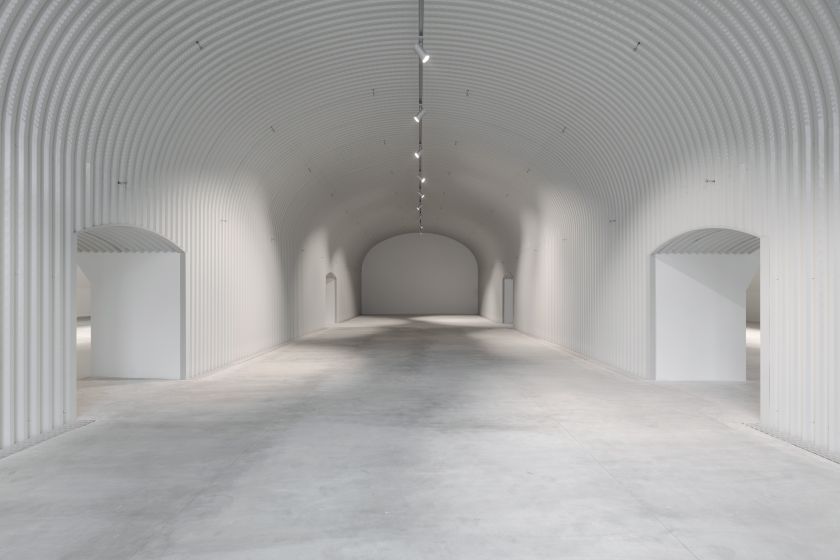The new Milan-based architecture and design hub opens its doors with Prison Times—Spatial Dynamics of Penal Environments, a powerful exhibition that unpacks the hidden spatial, social, and economic dynamics of prison life.
When it comes to architecture, some of the most rigid and regulated spaces are also the least seen. Prisons, with their harsh geometries and repetitive routines, exist in a world apart – physically contained, socially distanced, and emotionally opaque.
Dropcity, Milan’s new urban centre for architecture and design, is changing that with a bold inaugural exhibition: Prison Times – Spatial Dynamics of Penal Environments. Running from 3 April to 31 May 2025 and spread across five of Dropcity’s repurposed railway tunnels, the exhibition spans over 1,000 square metres and offers an unflinching look at the carceral world.
Through an archive of objects drawn from prisons around the globe—displayed in clinical, taxonomic arrangements—visitors are invited to interrogate the unseen mechanics of incarceration and the material culture of control.
The ambition of Prison Times is clear: to bring into focus an environment often kept out of sight and, by extension, out of mind. As Andrea Caputo, architect and founder of Dropcity, says: “The topic of incarceration is fraught with social, political, and ethical dimensions. However, this is precisely why we chose it as the first exhibition at Dropcity – our goal is to create a space that encourages critical engagement and open dialogue about under-reported social issues.”
For Caputo and his team, this is about more than highlighting the overlooked; it’s about revealing the deeply embedded role of design in shaping how incarceration is lived, structured, and enforced.
The Dropcity Space
Credit: Piercarlo Quecchia at DSL Studio
Credit: Piercarlo Quecchia at DSL Studio
Unlike most exhibitions that might lean toward empathy or aesthetics, Prison Times opts for something more disarming. Objects—ranging from prison-issue clothing and utensils to routine equipment—are presented with museum-like detachment, labelled, ordered, and repeated. The display mirrors the standardisation of prison life itself. This almost forensic mode of curation strips the objects of sentimentality, revealing their functional brutality.
“By presenting them in a structured, repetitive manner, we highlight the ways in which these objects—though seemingly mundane—are shaped by highly specific design requirements dictated by the prison system,” says Caputo. “They’re durable, anonymous, and often oppressive. But they also reveal the logic of control and the spatial choreography of incarceration.”
In other words, every object is a microcosm of a much larger machine—the prison industrial complex.
While the exhibition is physically immersive, its conceptual focus is time (or rather, how time is experienced in prison). As Caputo explains, “Time in prison is never neutral; it is structured, regimented, and often experienced as an oppressive force.” The exhibition’s title, Prison Times, nods to this fragmented, fictional timescale, where the outside world runs on one clock and the incarcerated on another.
Here, objects become markers of both passing and stagnation. A simple toothbrush, used at the same time every day, becomes a symbol of routine; a plastic chair might signify both stillness and surveillance. Through this lens, the exhibition becomes a meditation on how design and space mould the temporal experience of inmates and how resistance, too, can manifest in the smallest of details.
The Dropcity Space
One of the curators’ more complex challenges was depicting incarceration without romanticising it. Pain and suffering, while inherent to the prison experience, are not aestheticised here. Instead, this show walks a careful line, combining research, data, and public dialogue with moments of artistic intervention.
Alongside the main exhibition, Dropcity has curated stand-alone installations by artists and designers who have independently explored themes of imprisonment. These perspectives offer contrast and depth, creating a dialogue between institutional structure and personal narrative.
A parallel lecture series, programmed by Francesca Verona and Valentina Verdolini, will host voices from across disciplines—artists, prison directors, journalists, and researchers—broadening the public’s understanding of incarceration and the systems that sustain it.
“Making complex topics accessible is not an insurmountable challenge—it’s a design issue,” says Caputo. “Often, we label issues as ‘problematic’ simply because we have not yet found an effective way to communicate them.”
Credit: Piercarlo Quecchia at DSL Studio
For Dropcity, the exhibition sets a precedent, not just in subject matter but in ambition. Located beneath Milan’s Central Station, the centre is already drawing international attention for its radical repurposing of disused tunnels into creative infrastructure. Prison Times is just the beginning. Future programming promises more cross-disciplinary exhibitions, workshops, lectures and community-led initiatives.
As Caputo sees it, Dropcity is not merely a venue but a catalyst. “Architecture and design have historically played a role in reinforcing the repressive nature of the carceral system,” he notes. “But they also have the potential to challenge and transform it. Designers, architects, and urban planners must recognise their role in shaping the built environment in ways that either perpetuate or disrupt systems of oppression.”
In this sense, it’s not a static exhibition. It’s an active provocation—a challenge to think, question, and reimagine what design can do.
Where much of the design world currently leans toward optimism and aesthetics, Prison Times offers something more challenging to digest but just as vital: reality. It turns the spotlight on design’s complicity in systems of control and its potential for reform.
It also marks an ambitious start for Dropcity, positioning it as a platform for rigorous cultural dialogue rather than just beautiful objects. By launching with such an urgent, layered topic, Dropcity makes a bold statement: that architecture and design should do more than decorate the world—they should help us understand it.

Leave a Reply